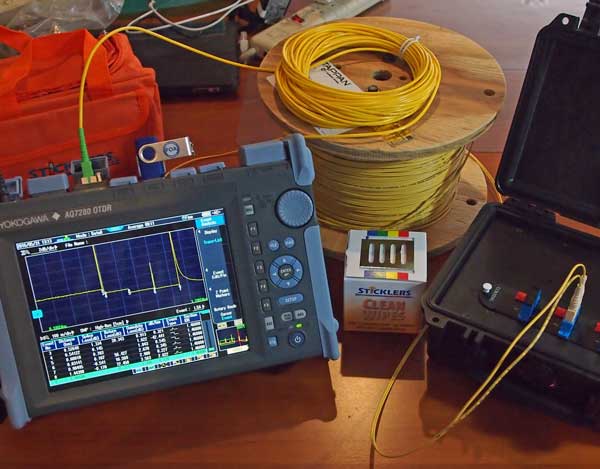Robotic vision supports optimizing manufacturing and quality control.
Robotic vision supports optimizing manufacturing and quality control.
Blog Article
Exploring the Benefits of Optical Fibre Testing for Improved Communication Equipments
The importance of optical fibre screening in contemporary communication systems can not be overemphasized, as it serves as a structure for ensuring network reliability and performance. This proactive screening technique has profound ramifications for signal top quality and functional effectiveness, raising the concern of how these practices add to long-lasting sustainability in an ever-evolving technical landscape.
Relevance of Optical Fiber Testing
The value of optical fibre testing can not be overstated in today's data-driven atmosphere. As organizations progressively count on high-speed information transmission for day-to-day procedures, the integrity and efficiency of optical fibre networks are extremely important. Testing makes sure that these networks can support the substantial amounts of information generated and transferred effortlessly, fostering efficient communication and connection.
Optical fiber screening offers multiple important functions, including validating installation quality, determining possible faults, and determining overall system performance. Regular screening can prevent costly downtimes and service disturbances, allowing companies to keep functional connection. It aids in conformity with industry criteria and laws, guaranteeing that fibre optic installments fulfill required specs for safety and security and reliability.
Additionally, screening can boost the longevity of fibre optic systems. By proactively identifying concerns such as signal loss, depletion, or port failings, organizations can attend to issues prior to they rise, therefore extending the life of their framework. In summary, optical fiber screening is not merely a technological demand yet a critical investment that improves network reliability, maximizes performance, and eventually supports the growth and effectiveness of contemporary communication systems.
Trick Testing Techniques

OTDR is an important technique used to identify mistakes, step splice losses, and assess the total integrity of a fibre optic web link. By sending out a pulse of light down the fiber and analyzing the reflected light, service technicians can pinpoint places of mistakes and examine the network's performance over fars away.
Insertion loss screening determines the quantity of signal loss that happens when light passes through a connection or splice. This approach is crucial for verifying that links fulfill specific loss thresholds, which is necessary for preserving optimum performance in communication systems.
Optical return loss screening quantifies the amount of light reflected back towards the resource as a result of imperfections in the fiber or connections. High return loss worths show far better performance and reduced signal destruction.
With each other, these testing approaches supply a thorough evaluation of fibre optic networks, guaranteeing their integrity and performance in varied interaction applications.
Influence On System Performance
Effective optical fiber testing directly influences the overall performance of interaction systems. By making sure the integrity of fibre optic cables, testing identifies potential faults such as depletion, splice loss, and connector misalignment. These issues can significantly degrade signal top quality, resulting in disturbances and lowered information transmission rates.

Additionally, normal optical fibre testing contributes to long-lasting system sustainability. It makes it possible for very early discovery of damage, enabling timely maintenance and upgrades prior to major failings take place. This not only extends the lifespan of the framework but likewise guarantees that communication systems continue to be affordable in terms of efficiency.
Cost-Effectiveness and Effectiveness
Cost-effectiveness is a crucial consideration in the deployment and maintenance of optical fibre networks. Implementing robust optical fiber testing treatments can dramatically minimize functional prices by determining issues before they intensify into major problems. optical fibre diameter analyser. By discovering faults, attenuation, and other performance obstacles early, companies can avoid pricey repair services and downtime, which can interrupt services and cause profits loss
Moreover, effective screening methods enhance the installment process, allowing service technicians to function better. This translates to decrease labour expenses and faster task completion times. Advanced testing tools, such as Optical Time Domain Name Reflectometers (OTDRs), allows an accurate assessment of Resources fibre top quality, making sure that just optimal products are made use of, thereby reducing waste.
Regular testing also adds to much better source allocation. By comprehending the network's performance, companies can make informed decisions about upgrades and growths, making sure that investments are made where they are most needed. In recap, optical fibre testing enhances cost-effectiveness and effectiveness, sustaining the long-term sustainability and competitiveness of communication systems in an increasingly demanding market.
Making Sure Long-Term Integrity
Executing strenuous optical fibre testing not just boosts price savings and operational effectiveness but additionally plays a critical duty in making certain the long-lasting dependability of communication networks. Regular screening techniques, including depletion and bandwidth assessments, aid identify possible degradation in fibre efficiency before it results in solution interruptions.
By using sophisticated testing methods, network drivers can identify faults or weaknesses in the fibre infrastructure, permitting timely remediation. This proactive method reduces downtime, guaranteeing that communication systems stay practical my company and effective. Routine testing contributes to the development of a more resilient network, as drivers can adapt and optimize their infrastructure based on real-time data insights.
In addition, guaranteeing compliance with industry criteria via optical fiber screening strengthens the top quality and honesty of the whole communication system. This adherence not only bolsters confidence amongst stakeholders but additionally aligns with governing requirements, which are progressively rigid.
Verdict
In conclusion, optical fiber testing offers as an essential element in boosting communication systems. By employing various testing approaches, such as OTDR and insertion loss assessments, networks can attain optimal performance and dependability. The positive identification of faults not only improves signal top quality but likewise reduces downtime, eventually contributing to cost-effectiveness and operational efficiency. Furthermore, adherence to industry criteria fosters stakeholder confidence, guaranteeing the lasting sustainability of communication frameworks in a significantly data-driven landscape.
Report this page